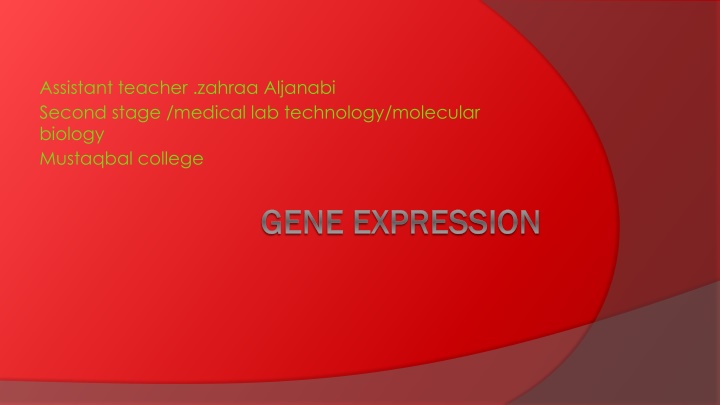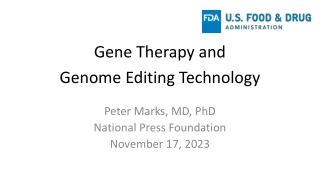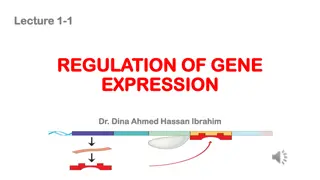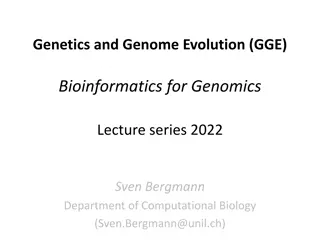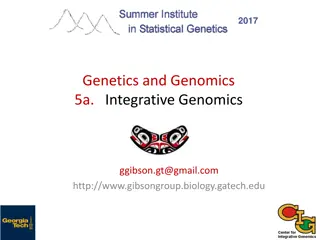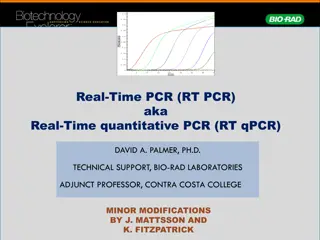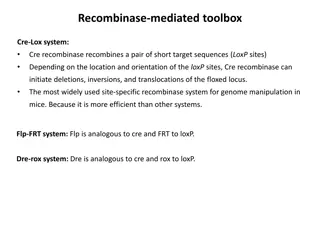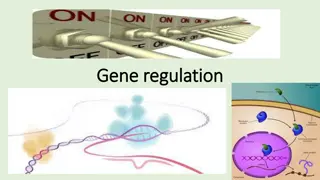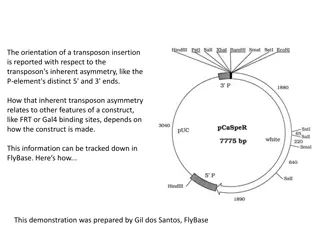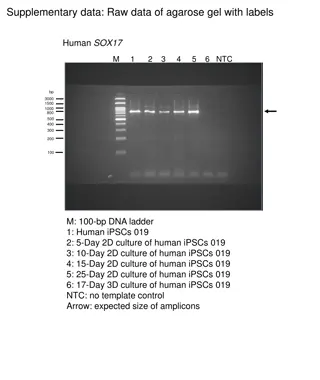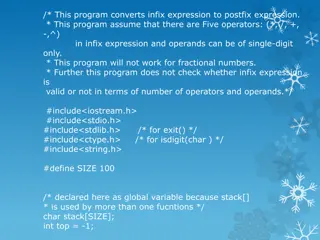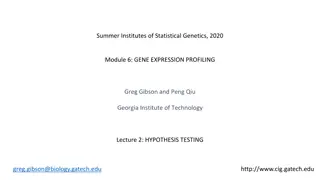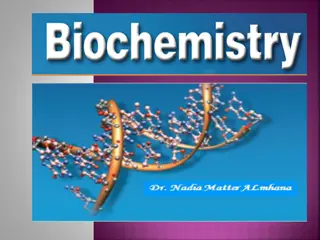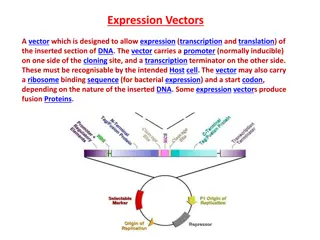GENE EXPRESSION
Gene expression is the process through which genetic information is utilized to produce functional gene products like proteins and RNA molecules. It involves transcription, translation, and posttranslational modifications that regulate the activity of proteins. Regulation of gene expression occurs at various levels, including transcriptional control and epigenetic changes to the genome. Transcription factors play a crucial role in activating or repressing gene expression by interacting with specific DNA sequences.
Download Presentation

Please find below an Image/Link to download the presentation.
The content on the website is provided AS IS for your information and personal use only. It may not be sold, licensed, or shared on other websites without obtaining consent from the author.If you encounter any issues during the download, it is possible that the publisher has removed the file from their server.
You are allowed to download the files provided on this website for personal or commercial use, subject to the condition that they are used lawfully. All files are the property of their respective owners.
The content on the website is provided AS IS for your information and personal use only. It may not be sold, licensed, or shared on other websites without obtaining consent from the author.
E N D
Presentation Transcript
Assistant teacher .zahraa Aljanabi Second stage /medical lab technology/molecular biology Mustaqbal college GENE EXPRESSION GENE EXPRESSION
Gene Expression Gene Expression and Regulation Gene expression is the process by which information from a gene is used in the synthesis of a functional gene product. Products 1- Proteins - 2 Non-protein coding genes such as ribosomal RNA (rRNA), transfer RNA
Gene Expression EX: the somatic cell contains the information required to synthesize thousands of different proteins and RNA molecules There are several potential sites for regulation starting with DNA , transcription , posttranslational modification of a newly synthesized protein.
Gene Expression epigenetic changes to the genome involve both chemical and structural modifications to the chromatin and DNA, Most proteins modified after translation and this can control their activities
Regulation of Gene Expression Regulation of gene expression can occur at different levels. A. Transcriptional control When and how often a gene sequence is copied into RNA is termed transcriptional control and this occurs at two levels: 1.structural-chemical modifications convert compacted chromatin into a less tightly coiled DNA structure, allowing access by transcription factors required for gene expression.2- binding proteins, known as transcription factors, modulate gene expression to turn transcription on or off.
Regulation of gene expression There are two categories of transcription factors 1. General (basal) transcription factors: General transcription factors are proteins that assemble on all genes transcribed by RNA polymerase II. These transcription factors are important for activate RNA polymerase Il at the start of a protein-coding sequence 2. Specifie transcription factors: Specific transeriptional factors or gene regulatory proteins are present in very few copies in the individual cells and perform their function by binding to a specific DNA nucleotide sequence and allowing the genes that they control to be activated or repressed. These proteins recognize short stretches of double-stranded DNA of defi ned sequence and thereby determine which of the thousands of genes in a cell will be transcribed.
Regulation of gene expression B. RNA processing control The primary transcript is produced as heterogeneous nuclear RNA containing introns which are eventually spliced out to create the mature mRNA. This process occurs in the nucleus and the subsequent processing is necessary to control the number of MRNA molecuies that are eventually translated. 1. MRNA capping: The addition of the 5' cap structure is critical for an MRNA to be translated in the cytoplasm and is also needed to protect the growing RNA chain from degradation in the nucleus by 5' exonucleases,
Regulation of gene expression 2. Poly(A) tail: The second modification of an MRNA transcript occurs at its 3' end, the addition of a poly(A) tail (approx. 200 adenine nucleotide residues are added). The polyadenylation reaction is an important regulatory step because the length of poly(A) tail modulates both mRNA stability and translation efficieney. The poly(A) tail protects the MRNA from premature degradation by 3'exonucleases 3. Removal of introns: Following the modification of the 5' and 3' ends of the primary transcript, the noninformational intron segments are removed and the coding exon sequences joined together by RNA splicing. The specificity of exon joining is conferred by the presence of signal sequences marking the beginning (5' donor site) and the end (3' acceptor site) of the intron segment. As these signal sequences are highly conserved, alterations in these sequences can lead to aberrant mRNA molecules. DNA
Regulation of gene expression 4.Alternative splicing: The ability of the genes to form multiple proteins by joining different exon segments in the primary transcript is called altermative splicing.
. RNA splicing also allows switching between the production of nonfunctional and functional proteins,. The ability to make more than one protein product from a gene may also explain why the human genome has fewer genes than expected
